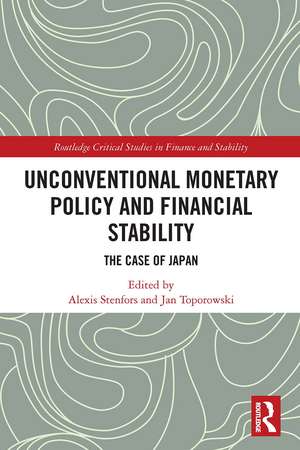Unconventional Monetary Policy and Financial Stability: The Case of Japan: Routledge Critical Studies in Finance and Stability
Editat de Alexis Stenfors, Jan Toporowskien Limba Engleză Paperback – 29 apr 2022
Unconventional Monetary Policy and Financial Stability critically assesses the measures used by Japan and examines what they have meant for the theory and practice of economic policy. The book shows how in practice unconventional monetary policy has worked through its impact on the financial markets. The text aims to generate an understanding of why such measures were introduced and how the Japanese system has subsequently changed regarding aspects such as governance and corporate balance sheets. It provides a comprehensive study of developments in Japanese money markets with the intent to understand the impact of policy on the debt structures that appear to have caused Japan’s deflation. The topics covered range from central bank communication and policymaking to international financial markets and bank balance sheets.
This text is of great interest to students and scholars of banking, international finance, financial markets, political economy, and the Japanese economy.
| Toate formatele și edițiile | Preț | Express |
|---|---|---|
| Paperback (1) | 322.60 lei 6-8 săpt. | |
| Taylor & Francis – 29 apr 2022 | 322.60 lei 6-8 săpt. | |
| Hardback (1) | 1001.39 lei 6-8 săpt. | |
| Taylor & Francis – 16 iul 2020 | 1001.39 lei 6-8 săpt. |
Din seria Routledge Critical Studies in Finance and Stability
-
 Preț: 288.26 lei
Preț: 288.26 lei -
 Preț: 292.83 lei
Preț: 292.83 lei - 28%
 Preț: 852.88 lei
Preț: 852.88 lei -
 Preț: 489.26 lei
Preț: 489.26 lei -
 Preț: 349.38 lei
Preț: 349.38 lei -
 Preț: 349.53 lei
Preț: 349.53 lei - 17%
 Preț: 172.64 lei
Preț: 172.64 lei - 12%
 Preț: 312.43 lei
Preț: 312.43 lei - 16%
 Preț: 299.52 lei
Preț: 299.52 lei - 17%
 Preț: 172.64 lei
Preț: 172.64 lei - 18%
 Preț: 1001.84 lei
Preț: 1001.84 lei -
 Preț: 381.98 lei
Preț: 381.98 lei - 19%
 Preț: 269.76 lei
Preț: 269.76 lei -
 Preț: 413.33 lei
Preț: 413.33 lei - 20%
 Preț: 264.13 lei
Preț: 264.13 lei -
 Preț: 382.32 lei
Preț: 382.32 lei - 18%
 Preț: 274.06 lei
Preț: 274.06 lei - 22%
 Preț: 324.29 lei
Preț: 324.29 lei -
 Preț: 389.38 lei
Preț: 389.38 lei - 14%
 Preț: 325.70 lei
Preț: 325.70 lei - 16%
 Preț: 225.30 lei
Preț: 225.30 lei - 18%
 Preț: 1005.39 lei
Preț: 1005.39 lei - 18%
 Preț: 1003.30 lei
Preț: 1003.30 lei
Preț: 322.60 lei
Preț vechi: 377.86 lei
-15% Nou
Puncte Express: 484
Preț estimativ în valută:
61.74€ • 64.22$ • 50.97£
61.74€ • 64.22$ • 50.97£
Carte tipărită la comandă
Livrare economică 12-26 aprilie
Preluare comenzi: 021 569.72.76
Specificații
ISBN-13: 9780367507251
ISBN-10: 0367507250
Pagini: 216
Ilustrații: 136
Dimensiuni: 156 x 234 mm
Greutate: 0.32 kg
Ediția:1
Editura: Taylor & Francis
Colecția Routledge
Seria Routledge Critical Studies in Finance and Stability
Locul publicării:Oxford, United Kingdom
ISBN-10: 0367507250
Pagini: 216
Ilustrații: 136
Dimensiuni: 156 x 234 mm
Greutate: 0.32 kg
Ediția:1
Editura: Taylor & Francis
Colecția Routledge
Seria Routledge Critical Studies in Finance and Stability
Locul publicării:Oxford, United Kingdom
Public țintă
Postgraduate and UndergraduateCuprins
Preface. Introduction (1) The Japan Premium and the first stage of the monetary transmission mechanism (2) The foreign currency swap market: A perspective from policymakers (3) The effectiveness of unconventional monetary policy on Japanese bank lending (4) Japanese banks in the international money markets (5) The Japanese balance sheet recession 20 Years on: Abenomics – economic revival or corporate financialisation? (6) An analysis of the impact of the Bank of Japan’s monetary policy on Japanese government bonds’ low nominal yields (7) Unconventional monetary policy announcements and Japanese bank stocks (8) Bank of Japan and the ETF market (9) Quantitative and Qualitative Monetary Easing, negative interest rates and the stability of the financial system in Japan
Notă biografică
Alexis Stenfors is Senior Lecturer in Economics and Finance at the University of Portsmouth, UK.
Jan Toporowski is Professor of Economics and Finance at SOAS University of London, UK.
Jan Toporowski is Professor of Economics and Finance at SOAS University of London, UK.
Descriere
Having faced a crisis in its banking sector nearly a decade earlier, Japan was a pioneer in the use of many unconventional monetary policies used during the global financial crisis of 2008-09. This book assesses measures taken by Japan and examines what they have meant for the practice of economic policy.
